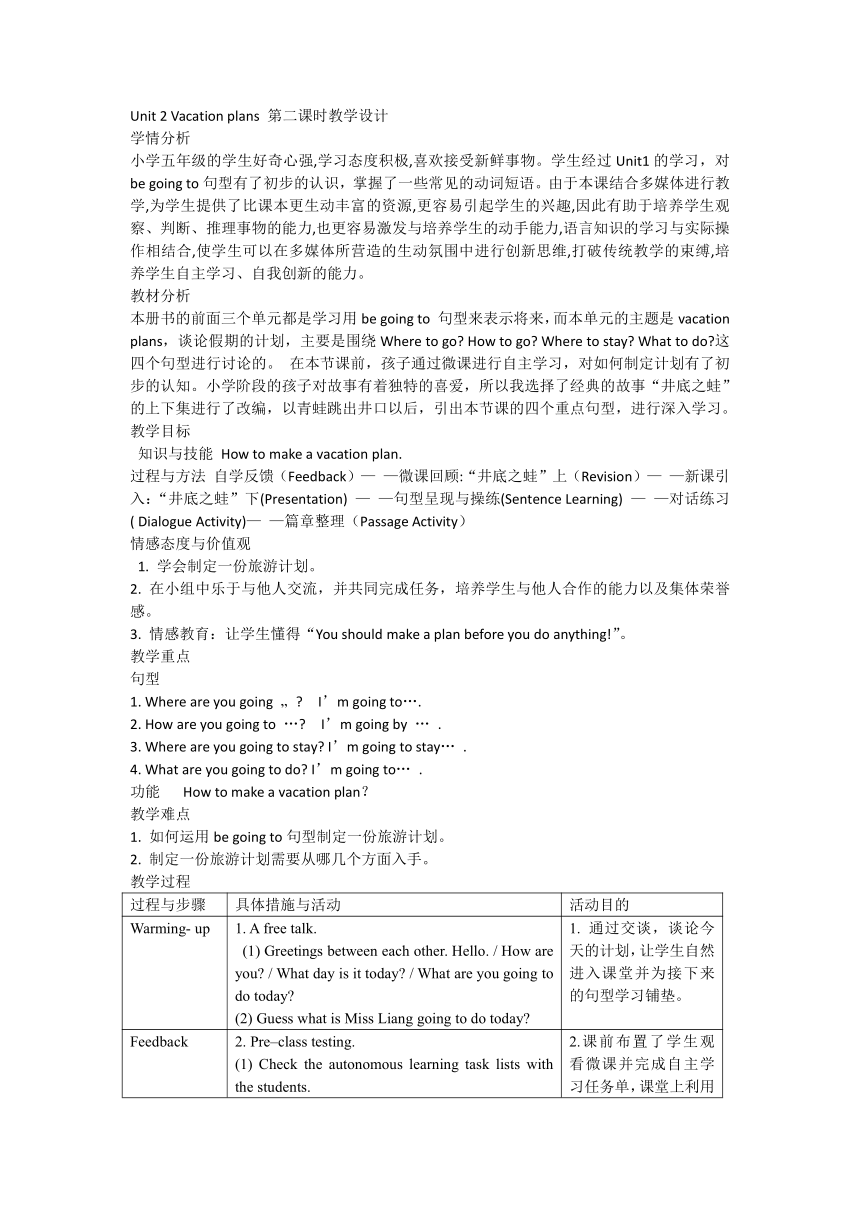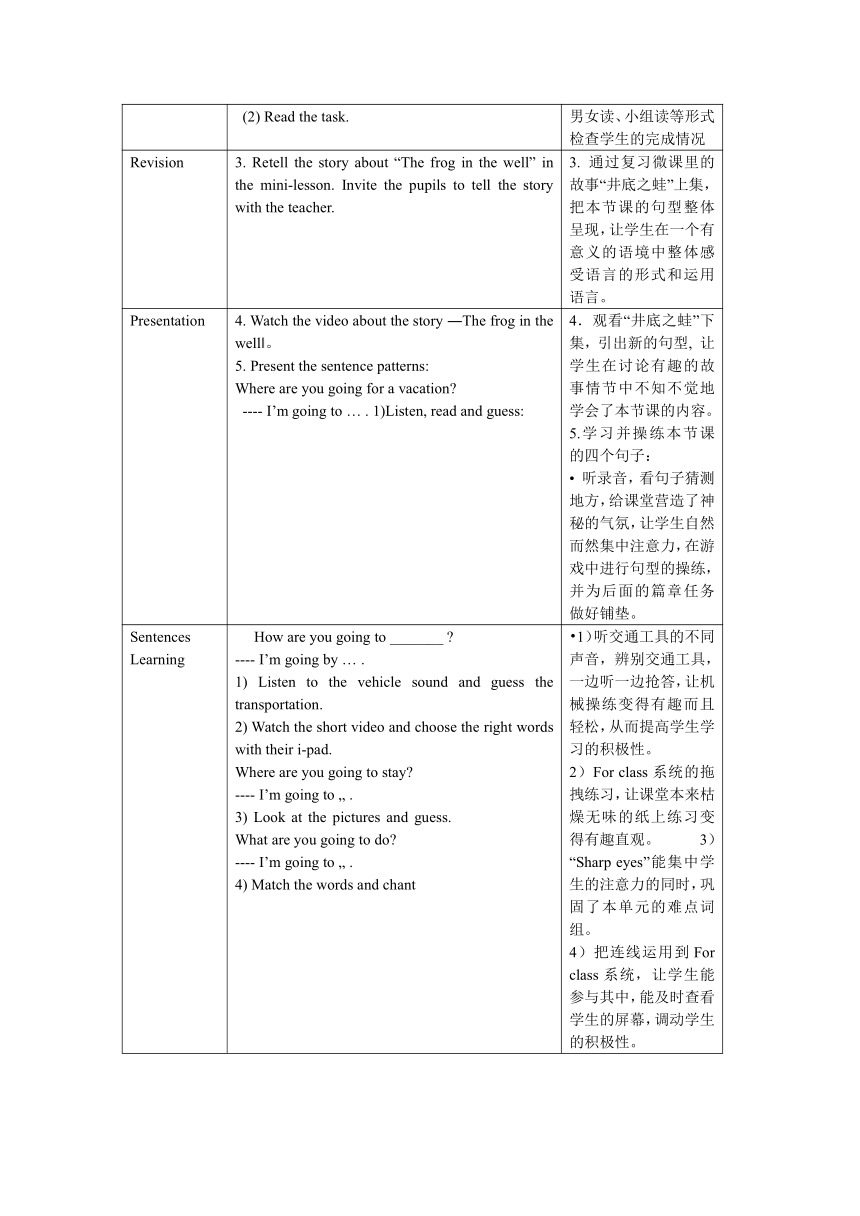Unit 2 Vacation Plans第二课时表格式教案
文档属性
| 名称 | Unit 2 Vacation Plans第二课时表格式教案 |  | |
| 格式 | docx | ||
| 文件大小 | 307.3KB | ||
| 资源类型 | 教案 | ||
| 版本资源 | 广东版 | ||
| 科目 | 英语 | ||
| 更新时间 | 2023-09-11 19:25:52 | ||
图片预览


文档简介
Unit 2 Vacation plans 第二课时教学设计
学情分析
小学五年级的学生好奇心强,学习态度积极,喜欢接受新鲜事物。学生经过Unit1的学习,对be going to句型有了初步的认识,掌握了一些常见的动词短语。由于本课结合多媒体进行教学,为学生提供了比课本更生动丰富的资源,更容易引起学生的兴趣,因此有助于培养学生观察、判断、推理事物的能力,也更容易激发与培养学生的动手能力,语言知识的学习与实际操作相结合,使学生可以在多媒体所营造的生动氛围中进行创新思维,打破传统教学的束缚,培养学生自主学习、自我创新的能力。
教材分析
本册书的前面三个单元都是学习用be going to 句型来表示将来,而本单元的主题是vacation plans,谈论假期的计划,主要是围绕Where to go How to go Where to stay What to do 这四个句型进行讨论的。 在本节课前,孩子通过微课进行自主学习,对如何制定计划有了初步的认知。小学阶段的孩子对故事有着独特的喜爱,所以我选择了经典的故事“井底之蛙”的上下集进行了改编,以青蛙跳出井口以后,引出本节课的四个重点句型,进行深入学习。
教学目标
知识与技能 How to make a vacation plan.
过程与方法 自学反馈(Feedback)— —微课回顾:“井底之蛙”上(Revision)— —新课引入:“井底之蛙”下(Presentation) — —句型呈现与操练(Sentence Learning) — —对话练习 ( Dialogue Activity)— —篇章整理(Passage Activity)
情感态度与价值观
1. 学会制定一份旅游计划。
2. 在小组中乐于与他人交流,并共同完成任务,培养学生与他人合作的能力以及集体荣誉感。
3. 情感教育:让学生懂得“You should make a plan before you do anything!”。
教学重点
句型
1. Where are you going I’m going to….
2. How are you going to … I’m going by … .
3. Where are you going to stay I’m going to stay… .
4. What are you going to do I’m going to… .
功能 How to make a vacation plan?
教学难点
1. 如何运用be going to句型制定一份旅游计划。
2. 制定一份旅游计划需要从哪几个方面入手。
教学过程
过程与步骤 具体措施与活动 活动目的
Warming- up 1. A free talk. (1) Greetings between each other. Hello. / How are you / What day is it today / What are you going to do today (2) Guess what is Miss Liang going to do today 1. 通过交谈,谈论今天的计划,让学生自然进入课堂并为接下来的句型学习铺垫。
Feedback 2. Pre–class testing. (1) Check the autonomous learning task lists with the students. (2) Read the task. 2.课前布置了学生观看微课并完成自主学习任务单,课堂上利用男女读、小组读等形式检查学生的完成情况
Revision 3. Retell the story about “The frog in the well” in the mini-lesson. Invite the pupils to tell the story with the teacher. 3. 通过复习微课里的故事“井底之蛙”上集,把本节课的句型整体呈现,让学生在一个有意义的语境中整体感受语言的形式和运用语言。
Presentation 4. Watch the video about the story ―The frog in the well‖。 5. Present the sentence patterns: Where are you going for a vacation ---- I’m going to … . 1)Listen, read and guess: 4.观看“井底之蛙”下集,引出新的句型, 让学生在讨论有趣的故事情节中不知不觉地学会了本节课的内容。 5.学习并操练本节课的四个句子: 听录音,看句子猜测地方,给课堂营造了神秘的气氛,让学生自然而然集中注意力,在游戏中进行句型的操练,并为后面的篇章任务做好铺垫。
Sentences Learning How are you going to _______ ---- I’m going by … . 1) Listen to the vehicle sound and guess the transportation. 2) Watch the short video and choose the right words with their i-pad. Where are you going to stay ---- I’m going to . 3) Look at the pictures and guess. What are you going to do ---- I’m going to . 4) Match the words and chant 1)听交通工具的不同声音,辨别交通工具,一边听一边抢答,让机械操练变得有趣而且轻松,从而提高学生学习的积极性。 2)For class系统的拖拽练习,让课堂本来枯燥无味的纸上练习变得有趣直观。 3)“Sharp eyes”能集中学生的注意力的同时,巩固了本单元的难点词组。 4)把连线运用到For class系统,让学生能参与其中,能及时查看学生的屏幕,调动学生的积极性。
Dialogue Activities 2) Students listen and watch the video, answer the questions with the i-pad. 6.Practice the dialogue: 1) Read the sentences on the blackboard to make a whole dialogue. 2) Choose the pictures to make a new dialogue with partner. 学生在For class 系统里面观看视频,完成单项选择题,学生可以根据自己的实际情况选择暂停或者重播;还能及时反馈学生答题速度和答题情况,让有限的课堂更加高效。 学生使用For class 系统的手写功能,能圈出自己所选择的图片,教师也可通过查看学生的屏幕,给传统的同桌对话注入了新鲜的元素。
Passage Activities 7. Draw and write: Please design a postcard about the Class Trip in your group. 8. Talk about the postcard. Let the pupils talk about the postcard in groups. 9. Show Time. 10. Vote: which group do you like best, please vote. 8.让学生在小组内以自己喜欢的方式来展示班级旅行的计划,可以一起展示,也可以每人一句,形式多样,学生可以自由选择。 9.小组上台展示。 10.利用For class 系统的投票功能,推选出优胜的小组。投票的数据是及时反馈的,让投票更加透明公平,大大增加了学生的学习兴趣。
Consolidation: 11. Consolidation: 11. 对学生进行情感教育:you should make a plan before you do anything.
Homework You should make a plan before you do anything. 12. Homework: 1). Write the passage about the Class Trip. 2). Share the plan with your parents. 12.课后通过写作来巩固本节课的知识。
学情分析
小学五年级的学生好奇心强,学习态度积极,喜欢接受新鲜事物。学生经过Unit1的学习,对be going to句型有了初步的认识,掌握了一些常见的动词短语。由于本课结合多媒体进行教学,为学生提供了比课本更生动丰富的资源,更容易引起学生的兴趣,因此有助于培养学生观察、判断、推理事物的能力,也更容易激发与培养学生的动手能力,语言知识的学习与实际操作相结合,使学生可以在多媒体所营造的生动氛围中进行创新思维,打破传统教学的束缚,培养学生自主学习、自我创新的能力。
教材分析
本册书的前面三个单元都是学习用be going to 句型来表示将来,而本单元的主题是vacation plans,谈论假期的计划,主要是围绕Where to go How to go Where to stay What to do 这四个句型进行讨论的。 在本节课前,孩子通过微课进行自主学习,对如何制定计划有了初步的认知。小学阶段的孩子对故事有着独特的喜爱,所以我选择了经典的故事“井底之蛙”的上下集进行了改编,以青蛙跳出井口以后,引出本节课的四个重点句型,进行深入学习。
教学目标
知识与技能 How to make a vacation plan.
过程与方法 自学反馈(Feedback)— —微课回顾:“井底之蛙”上(Revision)— —新课引入:“井底之蛙”下(Presentation) — —句型呈现与操练(Sentence Learning) — —对话练习 ( Dialogue Activity)— —篇章整理(Passage Activity)
情感态度与价值观
1. 学会制定一份旅游计划。
2. 在小组中乐于与他人交流,并共同完成任务,培养学生与他人合作的能力以及集体荣誉感。
3. 情感教育:让学生懂得“You should make a plan before you do anything!”。
教学重点
句型
1. Where are you going I’m going to….
2. How are you going to … I’m going by … .
3. Where are you going to stay I’m going to stay… .
4. What are you going to do I’m going to… .
功能 How to make a vacation plan?
教学难点
1. 如何运用be going to句型制定一份旅游计划。
2. 制定一份旅游计划需要从哪几个方面入手。
教学过程
过程与步骤 具体措施与活动 活动目的
Warming- up 1. A free talk. (1) Greetings between each other. Hello. / How are you / What day is it today / What are you going to do today (2) Guess what is Miss Liang going to do today 1. 通过交谈,谈论今天的计划,让学生自然进入课堂并为接下来的句型学习铺垫。
Feedback 2. Pre–class testing. (1) Check the autonomous learning task lists with the students. (2) Read the task. 2.课前布置了学生观看微课并完成自主学习任务单,课堂上利用男女读、小组读等形式检查学生的完成情况
Revision 3. Retell the story about “The frog in the well” in the mini-lesson. Invite the pupils to tell the story with the teacher. 3. 通过复习微课里的故事“井底之蛙”上集,把本节课的句型整体呈现,让学生在一个有意义的语境中整体感受语言的形式和运用语言。
Presentation 4. Watch the video about the story ―The frog in the well‖。 5. Present the sentence patterns: Where are you going for a vacation ---- I’m going to … . 1)Listen, read and guess: 4.观看“井底之蛙”下集,引出新的句型, 让学生在讨论有趣的故事情节中不知不觉地学会了本节课的内容。 5.学习并操练本节课的四个句子: 听录音,看句子猜测地方,给课堂营造了神秘的气氛,让学生自然而然集中注意力,在游戏中进行句型的操练,并为后面的篇章任务做好铺垫。
Sentences Learning How are you going to _______ ---- I’m going by … . 1) Listen to the vehicle sound and guess the transportation. 2) Watch the short video and choose the right words with their i-pad. Where are you going to stay ---- I’m going to . 3) Look at the pictures and guess. What are you going to do ---- I’m going to . 4) Match the words and chant 1)听交通工具的不同声音,辨别交通工具,一边听一边抢答,让机械操练变得有趣而且轻松,从而提高学生学习的积极性。 2)For class系统的拖拽练习,让课堂本来枯燥无味的纸上练习变得有趣直观。 3)“Sharp eyes”能集中学生的注意力的同时,巩固了本单元的难点词组。 4)把连线运用到For class系统,让学生能参与其中,能及时查看学生的屏幕,调动学生的积极性。
Dialogue Activities 2) Students listen and watch the video, answer the questions with the i-pad. 6.Practice the dialogue: 1) Read the sentences on the blackboard to make a whole dialogue. 2) Choose the pictures to make a new dialogue with partner. 学生在For class 系统里面观看视频,完成单项选择题,学生可以根据自己的实际情况选择暂停或者重播;还能及时反馈学生答题速度和答题情况,让有限的课堂更加高效。 学生使用For class 系统的手写功能,能圈出自己所选择的图片,教师也可通过查看学生的屏幕,给传统的同桌对话注入了新鲜的元素。
Passage Activities 7. Draw and write: Please design a postcard about the Class Trip in your group. 8. Talk about the postcard. Let the pupils talk about the postcard in groups. 9. Show Time. 10. Vote: which group do you like best, please vote. 8.让学生在小组内以自己喜欢的方式来展示班级旅行的计划,可以一起展示,也可以每人一句,形式多样,学生可以自由选择。 9.小组上台展示。 10.利用For class 系统的投票功能,推选出优胜的小组。投票的数据是及时反馈的,让投票更加透明公平,大大增加了学生的学习兴趣。
Consolidation: 11. Consolidation: 11. 对学生进行情感教育:you should make a plan before you do anything.
Homework You should make a plan before you do anything. 12. Homework: 1). Write the passage about the Class Trip. 2). Share the plan with your parents. 12.课后通过写作来巩固本节课的知识。
